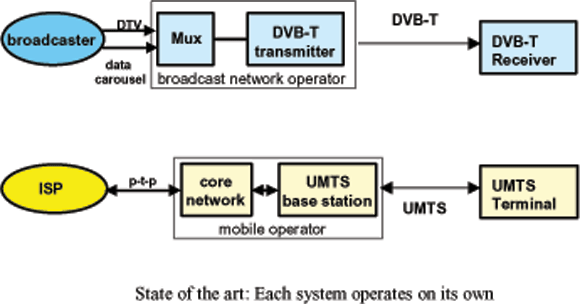 |
CONFLUENT Enabling Commercial Application of Convergent Service in Collaborative Networks of UMTS and DVB-T Systems. |
 |
|
| Home Objectives Scope Project Overview Innovation Partners | |||
| Innovation State-of-the-Art The current modus operandi of wireless transmission systems is each individual system operates on its own. This means that UMTS/GPRS provides communication service at much less than 2 Mbit/second whilst DVB-T provides broadcast services at much greater than 2Mbit/second. By combining UMTS/GPRS and DVB services the broadband of DVB-T is combined with the interactive medium and UMTS/GPRS to create a mobile terminal that can be used to provide significant services. The CONFLUENT project will lay the foundations for elements needs for the commercial exploitation of services "anywhere" combining UMTS and DVB-T.
Innovation and advance over state-of-the-art
Crucial to the commercial exploitation of any service combing UMTS and DVB-T is the availability of the
following system elements:
To achieve this target CONFLUENT will comprise the following core elements:
Innovations will include:
For true portable/handheld consumer terminals for hybrid services coupling broadcast and broadband services
we have to solve:
The DVB-T technique may be used as an extension of downstream capability either within or outside of the broadcast bands respecting, or not, channel broadcast width. A UMTS network with an integrated DVB-T downlink could be enhanced with a direct link between the broadcaster and an Internet Service Provider. Portable/handheld consumer terminals for hybrid services coupling broadcast and broadband services would thus provide widely available alternative platforms for Internet access. CONFLUENT takes steps to enabling the combination of UMTS cells with low power DVB cells (i.e. low radiating emissions) providing a service scenario for hotspots/small areas including "wireless cable TV" and Video-On- Demand through provision of extra DVB-T channels. This service scenario is suitable for both fixed hotspots like airports, malls, stations, stadiums, etc. And mobile hotspots such as trains, aircraft, cruise ships, etc. CONFLUENT seeks to make it simple for the end user to access hybrid services coupling broadcast and broadband services for data-retrieval, e-commerce, etc. By developing a complex technical interaction on the ground between networks, various service and content providers. This needs definition, generation, handling and control of all the metadata and control elements including security aspects, business concepts etc. The CONFLUENT project makes significant progress towards this objective by laying the foundations for elements needed for the commercial exploitation of services "anywhere" combining UMTS and DVB-T. |
|||
